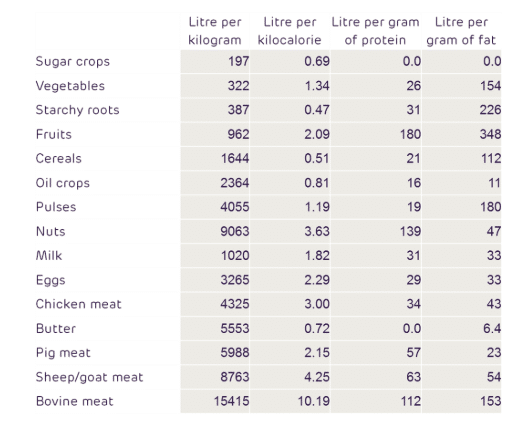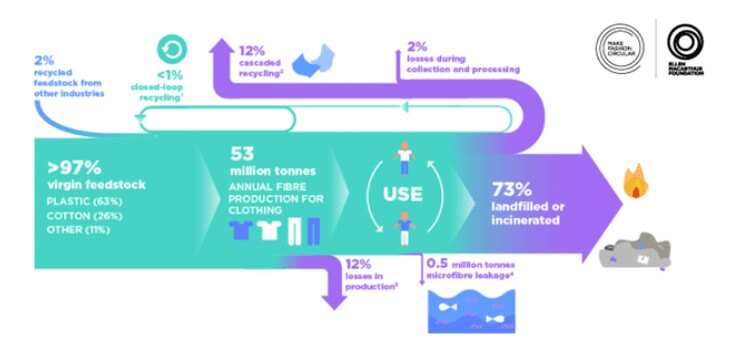Although water is embodied in every good and service we acquire, there seems to be a lack of awareness in water consumption. Our quickly-changing lifestyle could endanger future water supply as the absence of adequate water management systems, combined with current consumption patterns are putting future generations in front of a tough challenge when it comes to water.
The Food and Agriculture Organization of the United Nations (FAO) estimated that one-third of global food production is lost every year. As the food is lost, so are the resources invested in its production chain including water.
This case is particularly common to a high extent in medium and high-income countries[1]. Consumer behavior and lack of coordination between different actors in the supply chain lead to discarding food that is still in good condition for human consumption. Figure 1 shows a comparison of the water footprint associated with different food products.


Сonsidering that agriculture is responsible for withdrawing approximately 70% of freshwater sources, thinking of new ways of diverting food waste is essential. For example, creating educational campaigns for consumers, providing waste practices to restaurants to promote habits such as prevention and recycling[2], which could help to avoid wasting the water embodied in our food.

Beef and dairy products account for a large and important water footprint (WF). According to FAO, the industry is responsible for using about 10% of annual global water flows and 20% of blue water for feed production. Growing animal feed for cow meat is a very inefficient process that ends up utilizing around 25,000 liters of water per every 8 ounces of meat. A similar story is told by the processed food industry’s water footprint.
We currently count on a few tools that allow us to calculate our water footprint. However, there is still a need for mechanisms that make this information available to consumers. It’d help a lot to us as consumers to have the water footprint of each product in their tags.
Сonsumption patterns cover everything from the food we eat, the technology we use, the cars we drive, the clothes we wear, household water consumption, etc. We hardly realize how much water is involved in our current consumption trends.
Misinformation often leads to misconceptions about the topic. More efficient dishwashers or washing machines will cut down household water consumption, yet its impact is not as big as being more aware of the food we consume. Food is responsible for 60% of European households’ impact on water resources[1] as shown in Figure 2.
![Figure 2:Contribution of European households to water footprint[1]](https://bosaq.com/wp-content/uploads/2022/06/fast-moving-world-and-the-need-for-optimal-water-management-gr2.jpg)
Fashion is a water craving business, it relies heavily on water from cotton production, throughout the supply chain to clothes washing.
Fashion is the second-largest consumer of water globally, generating 20% of the global water waste. Textile processing, including spinning, dyeing, and finishing of one kilogram of fibersutilizes 100 to 150 liters of water.

Besides being water-thirsty, fashion is also a severely polluting industry. The simple act of washing clothes, releases 500,000 tons of microplastics to the ocean every year, equivalent to over 50 billion plastic bottles. Moreover, more than 1900 chemicals are used in clothing manufacturing.
Membrane filtration in the fashion industry is a preferred alternative when it comes to wastewater treatment. Since each textile has different water and processing requirements, membrane filtration offers a steady effluent quality, completely free of color and chemicals.
Treated wastewater can be completely reused within the production of clothes. For example, Levi’s made 100,000 pairs of jeans using 100% recycled water, claiming to have saved 12 million liters of water.
The four major direct factors determining the water footprint of a country are[3]
Apart from reducing the amount of consumed water, water reuse is a crucial element that would reduce the stress on water sources. Treated wastewater implies that a sanitation procedure has been performed, obtaining a double benefit.
Installing proper water management systems increase use efficiency and preserve resources.Those include water-wise designs, monitoring systems, rainwater harvesting systems (and using itfor all purposes other than drinking and cooking), and water filtering solutions are some of the available alternatives[4].
Our team of experts at BOSAQ can help you solve your water challenges in a sustainable way and calculate your Water Footprint, ensuring resource preservation and low impact. Sustainable design and integrated water management will help you optimize your water use while reducing your water footprint.
[1] D. Ivanova et al., “Environmental Impact Assessment of Household Consumption,” J. Ind. Ecol., vol. 20, no. 3, pp. 526–536, Jun. 2016.
[2] ReFED: Rethinking Food Waste, “Food waste is a solvable problem,” 2020. [Online]. Available: https://www.refed.com/solutions?sort=water-conservation. [Accessed: 26-May-2020].
[3] A. Y. Hoekstra and A. K. Chapagain, “Water footprints of nations: Water use by people as a function of their consumption pattern,” Water Resour. Manag. 2006 211, vol. 21, no. 1, pp. 35–48, Jun. 2006.
[4] P. Duhan, Green Consumerism: Perspectives, Sustainability, and Behavior. 2018.